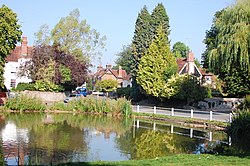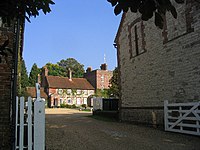Buriton
| Buriton | |
| Hampshire | |
|---|---|
 The village pond, Buriton | |
| Location | |
| Grid reference: | SU739200 |
| Location: | 50°58’37"N, 0°56’56"W |
| Data | |
| Population: | 736 (2001) |
| Post town: | Petersfield |
| Postcode: | GU31 |
| Local Government | |
| Council: | East Hampshire |
| Parliamentary constituency: |
East Hampshire |
Buriton is a village in eastern Hampshire, two miles south of Petersfield.
The village sits at the foot of the South Downs escarpment, just east of the A3 road. Half a mile to the south rises the tree-covered hill of Head Down (673 feet), one of the highest points of the South Downs and flanked on either side by two other high points, War Down (801 feet) and Oakham Hill (663 feet).
Parish church
The parish church is St Mary The Virgin. It was built in the late 12th century, with many additions of later ages: the chancel is of the 13th century, the tower from 1715, and other ages have left their marks. This used to be the church covering a large parish that included Petersfield, until the latter village grew into a substantial town.
Notable in the church are the mediæval sedilia, the Norman arches, and pillars bearing carvings of water lilies, foliage and scallops. It has a Norman font.[1] On the low side of the window in the south wall of the chancel is a mediæval mural painting of the Virgin and Child (13th century).[2]
History
About a mile north-west of Buriton was the extensive manor of West Mapledurham, formerly the property of the Bilson and Legge families, and later the Gibbons and Bonham-Carters. Edward Gibbon, author of the classic Decline and Fall of the Roman Empire, among other works, lived at Buriton Manor for much of the second half of the eighteenth century.[3] John Goodyer, the seventeenth-century botanist, was buried at St Mary's and is commemorated with a stained glass window there.
The local landowners until recent times, the Bonham-Carters, owned land surrounding Buriton and neighbouring villages where they often reared game for local shoots. The Legge family were gamekeepers for the Bonham-Carters for many years.[4] Other forms of employment in the past have been in the local lime kilns which closed in 1920.[5] Hop-picking was another form of employment in the past.[6] Today, Buriton remains a pleasant and quiet village with a very strong sense of its own identity. Employment needs are met outside the village.
About the village
The village has two tennis courts, two pubs - The Five Bells and The Nest Hotel & Restaurant, a village hall, a large village pond with ducks and fish, a car park and the Church of St. Mary. There is no shop in the village. The village has its own school, "Buriton Primary School", with about 80 pupils from the village and nearby.
It is a rural, peaceful place, with the possible exception of the main railway line, the Portsmouth to London line (Portsmouth Direct Line). The railway tunnel which carries the line under the South Downs is visible from the recreation ground. There was a pedestrian crossing over the railway at this point which the trains used to 'hoot' for as a warning to those crossing the line, the crossing is now closed after a public enquiry (Dec 2016). There remains the path under the railway bridge from South Lane, which is one of two crossings from the centre of the village. The path leads to the walks around the disused chalk pits and is part of the Shipwrights Way long distance path. Although for centuries the village was deemed of more importance than neighbouring Petersfield, Buriton never obtained its own railway station (aside from Woodcroft Halt, built during Second World War for naval personnel), because the gradient in the area was deemed too steep to allow a station to be constructed.[7]
This village formerly marked the Western end of the South Downs Way, which has now been extended to Winchester but several paths still join the village to the Way, and it retains its popularity with walkers. The Sussex Border Path also passes through South Harting which is close by. Buriton also lies adjacent to the Queen Elizabeth Country Park and since 2011 it has been within the South Downs National Park.
Outside links
| ("Wikimedia Commons" has material about Buriton) |
- Brief History
- St Mary The Virgin, Buriton
- Buriton Heritage Bank, community local history project
References
- ↑ Mee, Arthur: The King's England: Hampshire with the Isle of Wight (Hodder & Stoughton)
- ↑ Hampshire Churches, Margaret Green, Winton publications, 1976. Page160.
- ↑ Information sheet no. 5, Buriton Heritage Bank.
- ↑ Information sheet no. 5, Buriton Heritage Bank.
- ↑ Information sheet no. 1, Buriton Heritage Bank.
- ↑ Information sheet no. 3, Buriton Heritage Bank.
- ↑ Buriton Heritage Bank, Buriton In Living Memory; Godfrey Croughton, et al., Private and Untimetabled Railway Stations (Salisbury: Oakwood Press, 1982), p. 142.
- A History of the County of Hampshire - Volume 4 pp 85–93: Parishes: Buriton (Victoria County History)

